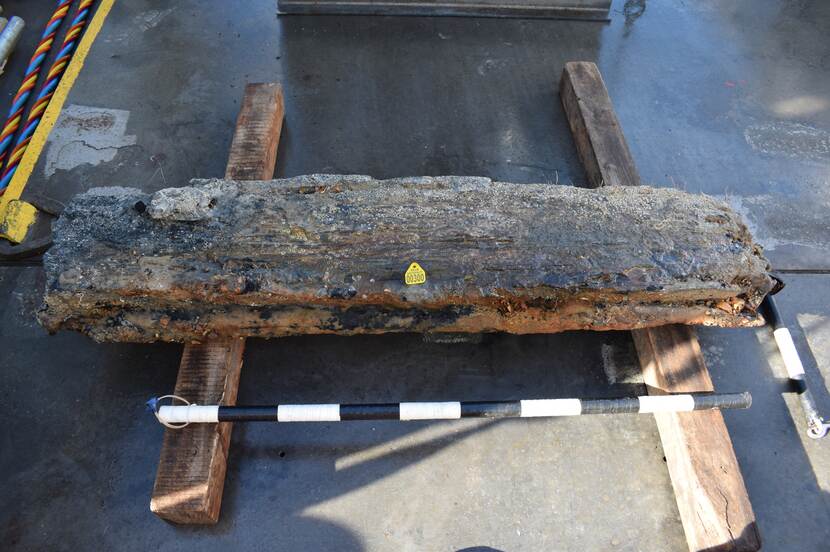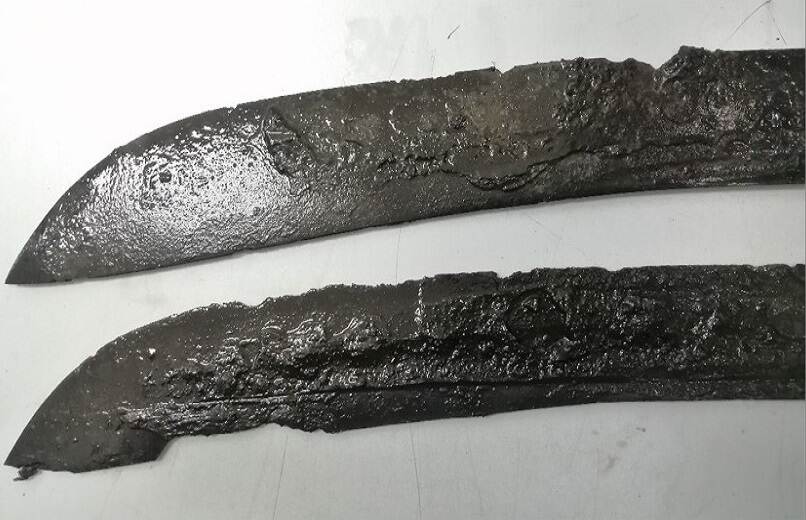The chest of 100 sabres
Weblog
In 2017 and 2018, excavations were undertaken on the protected wreck of the Dutch East India Company (VOC) ship Rooswijk. The #Rooswijk1740 project is led and funded by the Cultural Heritage Agency of the Netherlands (RCE) in collaboration with Historic England and MSDS Marine Ltd. Conservator Carola Del Mese of Historic England/MSDS Marine writes about working on one of the remarkable finds of the Rooswijk: a chest full of sabres.
In February 2022, Carola joined the conservation team at Historic England where she was introduced to the Rooswijk project. Maritime archaeologists spent two seasons diving the site of the Rooswijk wreck at the Goodwin Sands, recovering ship’s timbers, artefacts and concretions. A concretion is an accumulation of sediment, shells, silt and marine deposits which gather around a (usually) iron object, forming a hard, rock-like ‘concretion’, often gathering in surrounding objects. The result is a rock-like formation with objects inside. Carola explains the work needed to remove the concretion from a large object, and what she found inside:
The chest
Of the circa 3000 objects recovered from the wreck, there were in excess of 300 concretions, many of which were identified as casks and chests filled with cargo. One of which was a chest complete with its contents of 100 sabre blades – which we didn’t know at the time! The chest had already been de-concreted, which means that the outer layer of hard sediment had been removed, and it was Carola’s task to open the chest, safely excavate the contents and conserve them. (Fig 1)

My first task was to remove the remains of the wooden chest to reveal the objects inside. From initial investigation, we knew that the chest contained bladed weapons - blades only with no hilts - but we did not know their condition. Additionally, the iron weapons had corroded together, creating a solid block, and the corrosion had spread into the wood, making the wood hard, and difficult to remove. I removed the larger areas of wood very carefully with a hammer and chisel, making sure not to touch the underlying metal objects. (Fig 2) For the remaining outer areas I used an air scribe - an air-powered vibration tool which looks like a pen, with a vibrating nib.
Once the wood was removed, I was left with a large, solid block made of swords which had corroded together. Sediment and corrosion products had filled all the empty space around and between the swords, solidifying and further binding the blades together. At this stage the edges of the swords were visible from the side view, but their general condition was obscured by corrosion and concretion. (Fig 3) Initially the block was too heavy to lift manually, and had to be kept wet while I worked on it, so it was stored in a large tank of water overnight, and we used a small gantry crane to lift it onto a trolley each morning, returning it to the tank in the evening. (Fig 4)
[Click on the photos to enlarge]
Blades
The blades on the top layer were recognisable, but very fragmented and fragile, and thorough documentation was essential, in case these fragmented further. (Fig 5, fig 6) The blades in these top two layers contained almost no core metal, and were made of very black, powdery corrosion, which sometimes disintegrated into slurry. Any remaining metal quickly oxidised on contact with the air, becoming black. The second and third layers were in much better condition, with the pointed tips whole and visible, and the structure of the blades almost intact, although brittle and fragile. (Fig 7, fig 8)
[Click on the photos to enlarge]
In order to micro-excavate the blades from the block, I had to remove all the concretion from around the blades, using the air scribe (fig 9) and an ultrasonic de-scaler (fig 10). This is the same tool which the dentist uses to clean your teeth, it has a pointed tip and vibrates at a very high frequency, so it is much more accurate and less forceful than the air scribe. Working on each layer I removed all the concretion from the top and around the edges of each blade before attempting to lift the blade away from the block.
The tips of the blades were generally the most flexible area, and the tang (handle) was the thickest and also the most corroded area. When as much concretion as possible had been removed, I used fine steel dentists’ tools and wooden or plastic clay sculpting tools, starting from the tip to gently edge underneath, making sure not to mark or chip the blade. This released the blade from the concretion in a small area, allowing me to slide a flat wooden tool underneath to support it. I was then able to gently move the tool further underneath the blade and down towards the tang, inserting spacers underneath for support. Finally, the blade could be lifted out, and using this method I worked my way down the chest until all the blades had been removed. (Fig 11, fig 12)
I found that the condition of the blades improved towards the centre of the chest, uncovering some very well-preserved examples, and discovered that there were two distinct blade sizes. The larger was approximately 95 – 110cm long, weighing around 850g before cleaning, and the smaller was around 90cm long, weighing around 650g. The larger blades were packed four per layer and the smaller, six per layer, and all layers were placed alternately with the tip and the tang left or right. (Fig 13)
[Click on the photos to enlarge]
Cleaning the blades
Cleaning the blades fulfils two purposes: to reveal more of the object so we can understand it more clearly, and to stabilise the objects, slowing down deterioration so they can be studied and enjoyed. Removing concretion also helps to remove salt (or chlorides) from the object as the concretion retains chlorides. Chlorides are present in sea water, and are a big factor in causing corrosion, so removing the chloride-retaining concretion, helps to stabilise the object and prevent further corrosion.
Once the block was disassembled, cleaning of the individual blades began. Bearing in mind the scale of this project – approximately 100 swords - I had to consider the time scale, and decide what level of cleaning was achievable. The first stage would be to remove all the large remaining chunks of concretion from the blades using the air scribe. The second stage would be to clean in more detail, removing visible areas of corrosion using the ultrasonic de-scaler and by hand, and using a scalpel to remove smaller areas of concretion. (Fig 14)

Storage during conservation
As mentioned, the concreted block was stored in tap water, however, once the blades were disassembled from the block, they began to corrode at a faster rate. So, as the blades were removed from the block, they were stored in a tank of 1% Sodium Hydroxide in distilled water. This highly alkaline solution ‘passivates’ the iron and stops it from rusting. Once each blade had been through the second stage of cleaning, it was transferred to a tank containing a stronger solution (2% Sodium Hydroxide in distilled water) which causes a chemical reaction, actively desalinating the objects. This tank must be monitored, and the solution refreshed periodically to remove all the chlorides.
In the second part, Carola describes her discoveries after cleaning the blades.
